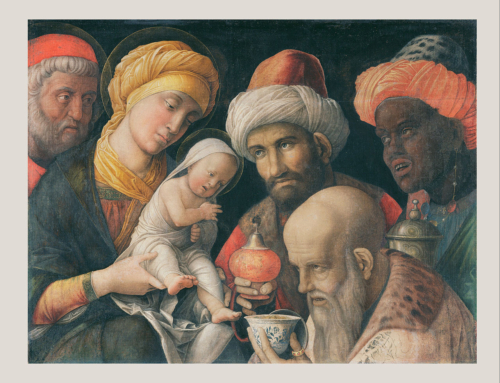When I was researching my book Mystery of the Magi – The Quest to Identify the Three Wise Men I discovered the extraordinary amount of legendary and mythical material surrounding the magi story.
More than any other gospel story, the tale of the wise men who came to pay homage to the Christ child attracted elaboration and legendary and mythical accretions. From the early second century the Protoevangelium of James began to add levels of detail to the story, but from there the storytelling went into the stratosphere.
An apocryphal writing from the third century is The Legend of Aphroditianus. This fairy tale begins with the account of a miracle in the temple of a pagan goddess in Persia at the time of Christ’s birth. According to the myth, the statues in the temple dance and sing and announce that the goddess Hera has been made pregnant by Zeus.
Suddenly a star appears above the statue of the goddess Hera. A voice from heaven is heard and all the dancing statues fall on their faces. The wise men of the court take this to mean that a King is to be born in Judah. That evening the god Dionysus confirms their interpretation. Then the king sends the Magi to Judea with gifts, the star pointing them along their way. The story tells of the Magi’s journey to Bethlehem, and how they meet the Jewish leaders and finally Mary and Jesus. They return to Persia bringing a portrait of Jesus and Mary and put it in the temple where the star first appeared.
What a load of gnostic hogwash.
A few years ago New Testament scholar Brent Landau came out with The Revelation of the Magi in which he published a gnostic fantasy tale about the Magi that is probably no older than the third century.
This story pretends to be told by the magi themselves. The wise men are residents of a mythical land called Shir in the Far East. They are the descendants of Seth, the third son of Adam and Eve, who passed on to them a prophecy from his father that one day a star of amazing brightness would appear to announce the birth of God in human form.
The story continues as every year the mystical magi of Shir ascended their Holy Mountain where the Cave of Treasures is located. This cave contains the wisdom of Seth and the treasures of Adam and it is there that the super bright star—brighter than the sun appears to them as a tiny, radiant human. The star child tells them to go on a long journey to Bethlehem. After long preparations they set off only to find that the star child accompanies them removing all obstacles and miraculously providing them with food and protection.
Once they get to Bethlehem, Mary accuses them of wanting to steal the child, but they inform her that he is the savior of the world. Finally they go home provided with more miraculous food. At last they reach the land of Shir and tell their people what has happened and they all rejoice. Then many years later the Apostle Thomas appears and baptizes them, and they all live happily ever after.
Once again–a complete load of tripe.
Now what is amazing is that the liberal scholars just love these gnostic apocryphal writings. They argue passionately for the earliest possible date for them while at the same time arguing for the latest possible date for the canonical gospels. I smell a rat. There’s an agenda here.
What is interesting about the gnostic infancy narratives, however, is how much they influenced the magi tradition in the West. Chapter three of my book outlines how these early fantasy stories about the magi seeped into the Western tradition and continued to be elaborated and embroidered down through the Middle Ages so that even today the popular version of the magi story is highly colored by them.
All of us–liberals and conservatives–read Matthew’s account through the lens of these later traditions. So, if you asked an ordinary Christian to recount the magi story they would probably say, “Three mysterious kings named Balthasar, Caspar and Melchior who were also wizards travelled from an exotic Eastern land on a long journey across the desert. They rode camels in a caravan as they followed a miraculous star.”
But of course, none of that is in Matthew’s gospel. They magi are not named. He doesn’t say they were kings. He doesn’t say there were three. He doesn’t say they went on a long journey across the desert. He doesn’t mention camels and he doesn’t even say they followed a mystical magical star. All of that was read back into the story as people accepted the mythical gnostic infancy narratives.
Because of this it is understandable that liberal scholars pooh-poohed the idea that the magi story might be historical. They didn’t really look at Matthew’s account in detail. They simply dismissed it as impossible. But what they were really dismissing was the mystical, magical gnostic version which colored their reading of Matthew.
The other reason the liberal scholars dismiss the story is because they think Matthew made it up in order to fulfill prophecies. They say the story is a “midrash” or an embroidered tale added to illustrate or hammer home a preaching point.
The first prophecy that Christians have understood as foretelling the visitation of the magi is from the Book of Numbers. The story takes place during the time when Moses was leading the Israelites through the desert. A non-Jewish seer and shaman named Balaam, who comes “from the East” is asked to cast a spell against the Israelites by Balak, the king of Moab.
In the following oracles Balaam predicts victory for the Israelites saying specifically, “I see him, but not now; I behold him, but not near: a star shall come out of Jacob, and a scepter shall rise out of Israel.”
From antiquity students of Scripture have spent a good bit of time and effort seeing the parallels between the Balaam story and the story of the Magi. New Testament scholar Raymond Brown has connected the dots and thinks Balaam was a kind of “magus” from the East and that Matthew has constructed his story to show how the visit of the Magi fulfills the Balaam story.
The difficulty with Brown’s hypothesis is that there are as many dissimilarities between the magi story and the Balaam story as there are similarities. At best we can conclude that Matthew certainly knew of the story of Balaam and his prophecy that “a star shall come out of Jacob” but even in this mention of the star, Balaam is referring to a coming Israelite ruler who will vanquish their enemies, whereas the magi saw a celestial phenomenon in the night sky. If Matthew were constructing the magi story to match the Balaam story, he didn’t do a very good job.
Likewise with the prophecies from Isaiah 60. The prophet says, “Raise your eyes and look about; they all gather and come to you—Your sons from afar, your daughters in the arms of their nurses. Then you shall see and be radiant, your heart shall throb and overflow. For the riches of the sea shall be poured out before you, the wealth of nations shall come to you. Caravans of camels shall cover you, dromedaries of Midian and Ephah; All from Sheba shall come bearing gold and frankincense, and heralding the praises of the Lord.”
If Matthew wrote the story of the Magi in order to fulfill this prophecy, again, he didn’t do a very good job. He should have included camels in his story and he should have left out the detail about the myrrh. He should also have included perhaps a gift of pearls so that the “riches of the sea” line could have been fulfilled. Furthermore when Matthew wants to show a prophecy being fulfilled he usually prefaces it with the line, “so that the prophecy might be fulfilled”. He doesn’t do this with the magi story.
What if the liberal scholars had spent just as much time actually researching the historical facts of the magi story rather than doing everything possible to undermine and doubt the historical veracity?
In fact, ironically, the liberal scholars have created their own level of myth and midrash about the magi story. Myth because they actually trust in the gnostic fantasy tales and have allowed their own thinking to be colored by them and midrash because they have spun their own false preaching points out of the story.
All this, and much more is discussed in my book Mystery of the Magi – the Quest to Identify the Three Wise Men. What has been the response to my book? Some New Testament scholars have read it and appreciated it. The more typical response has been to ignore it or in closing I’ll share this amusing response:
Liberal Bible Scholar: You should not mislead people. There is no historical basis for the Magi story.
DL: My book establishes the historical basis for the magi story.
LBS: But there is no historical foundation for the magi story. We have established that.
DL: How? With what evidence?
LBS: Well, everyone says so. It is agreed that there is not historical foundation for the magi story.
DL: My book establishes the historical foundation. Have you read my book? I’ll send you a free copy
LBS: I have sooo many books to read! I’ll have to decline your kind offer.
This week only, for Epiphany signed copies of my book are on sale at discounted price of $19.99 at my website. Go here for more information.






